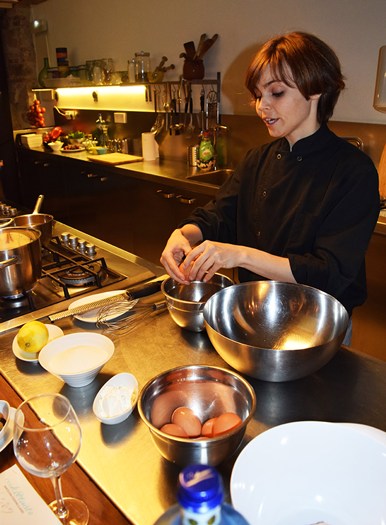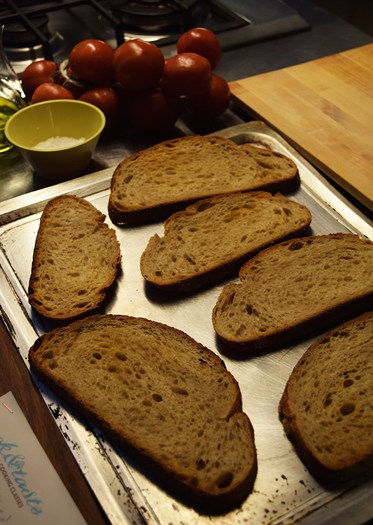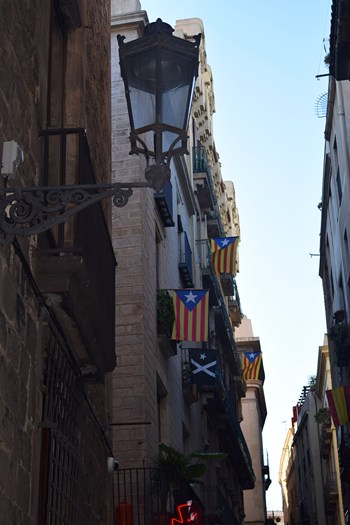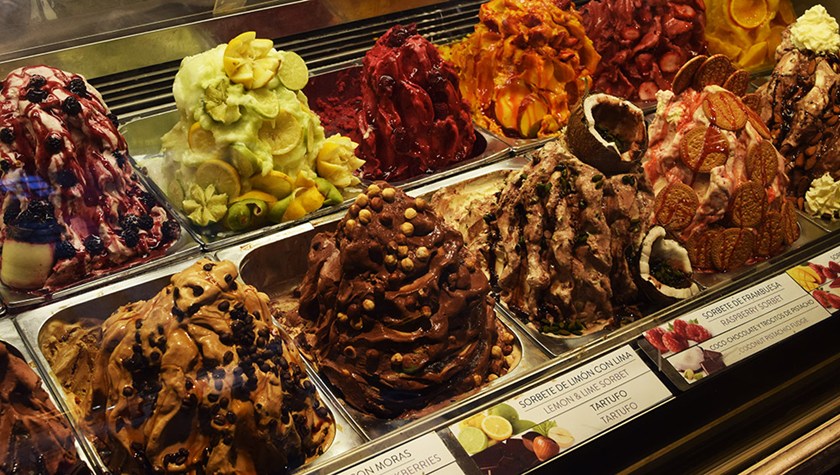BARCELONA - Food is a main ingredient in the Catalan culture and the region’s unique cuisine is one of the big reasons tourists find Barcelona so appetizing. Dishes here range from simple (tomatoes scrapped on toasted bread and topped with a high quality olive oil) to incredibly complex (comfit cod accompanied by spinach Catalan).
One thing all Catalan dishes have in common, though, is they’re all delicious.
A growing trend among tourists is to not just to sample Catalan cuisine in the many Barcelona restaurants that specialize in making it, but also finding out how to prepare certain dishes.
Which is why we’re following a Barcelona guide named Aicard through the city’s Gothic Quarter backstreets in search of a Catalan cooking school called Cook&Taste.
“We will have dinner at Cook&Taste but first you have to make it (the dishes),” says Aircard as we arrive at the front door where Chef Sara is waiting to greet us.


Above: Cooking instructor shows tourists how simple ingredients make Catalan cooking special.
Cook&Taste offers two unique packages - one is an in-kitchen experience for lunch or dinner for 65 euros per person or a lesson that combines a trip to Barcelona’s famed Boqueria market off the Ramblas (main street) where student chefs pick the ingredients and then return to the school to cook dishes with what they’ve bought. The latter option costs 78 euros per person. Because of time restraints, we opt for the in-school experience.
After outfitting our small group with aprons and utensils - suddenly I feel like a Food Network star - Chef Sara runs down the dishes she’ll be teaching us how to prepare.
“We’ll be making a Romesco Sauce, a Coca de Espinacas a la Catalana con Bacalao Conftiado (Spinach Catalan style flat bread with comfit cod) and a Fideus (short noodle seafood paella) for the main courses and for desert we’ll make Creme Catalana,” says the soft spoken chef who, like all Catalonians, talk passionately about the ingredients and cooking methods employed in this northern region.
And there’s indeed a rich history connected with Catalonia cuisine - in fact, the first known cookbook published in Europe “El Llibre de Sent Soví", circa 1324, contained mostly Catalan recipes. That book highlighted the importance of scents and flavours in Catalan cooking.


Above: After the lesson, frozen treats wait on the streets of Old Town Barcelona.
During the 14th and 15th centuries, it’s said feudal Catalan lords employed the best chefs of the era and it was well known throughout the Iberian peninsula that Catalonia food was the very best.
Early Spanish explorers, many of whom hailed from Barcelona, brought back ingredients from the New World that now form the basis of many Catalan dishes - potatoes, tomatoes, peppers, eggplant and especially chocolate, which was brought from Mexico by Conquistador Hernán Cortés. These vegetables were used to produce two very popular Catalan dishes - Samfaina and Escalivada.
Back in the kitchen, Chef Sara tells us the most important ingredient in Catalan cooking is freshness.
“If you don’t have the freshest ingredients, you cannot make the best food,” says the young Chef, who tells us that traditional Catalan cuisine is quite diverse, ranging from pork-intensive dishes cooked in the inland part of the region, to fish-based recipes along the coast.
“Our cuisine includes many preparations that mix sweet and savory and stews with sauces based upon botifarra (pork sausage) and the characteristic picada (ground almonds, hazelnuts, pine nuts, etc. sometimes with garlic, herbs, biscuits),” says Chef.
Interestingly, Sara starts us off by making desert.
“The Crema Catalana is the last thing we’ll eat but you have to make it first to give the mixture time to chill,” she tells us as she skillfully combines the ingredients (milk, the peel of 1 lemon, 1 stick of cinnamon, 6 egg yolks, 200 grams of sugar and 40 grams of corn starch) and then places the small pots into the fridge to set.
Sara says the cooking school employs four chefs and each class can contain as many as 14 people. She also recommends the “market experience” because “it truly gives you insight to local life and how Catalonians buy their food - they are very particular about the quality of the ingredients they choose.”
Next we prepare the Romesco Sauce and flat bread. The short noodle paella is amazing - unlike any paella I’ve tasted before.
“The Catalan people prefer short noodles as opposed to rice, which the Spanish prefer,” says Chef, who, like most other Catalonians, like to refer to themselves as an independent nation - Catalonia will actually vote on independence from Spain in the very near future.
All through the cooking lesson, pupils are served copious amounts of wine and a fun atmosphere prevails from start to finish.
Finally, we get to eat what we - okay, Chef did most of the cooking - prepared at tastefully decorated tables located at the back of the classroom.
The Romesco sauce spread over toasted bread is amazing; the flat bread excites our palettes; the seafood paella may be the best I’ve ever enjoyed; and the Crema Catalana is as sweet and fulfilling as the country it’s named after.
Catalan food certainly makes you want to keep coming back to Barcelona for more.
Information
To find out more about Cook&Taste, go to
www.cookandtaste.net. To reserve a group cooking lesson, contact Cook&Taste as info@cookandtaste.net / Some famous Catalan dishes: Catalan-style cod (with raisins and pine nuts); Escalivada (various grilled vegetables); Escudella (a stew, it may be served as soup with pasta and minced meats and vegetables, or as the soup first and then the rest); Ollada (meat and vegetable stew); Esqueixada (salted cod salad with tomato and onion); Mongetes amb botifarra (beans and pork sausage); Pa amb tomàquet (bread smeared with tomato and oil, and sometimes garlic); Tonyina en escabetx (tuna escabeche); Suquet de peix (a seafood casserole); Allioli (a thick sauce made of garlic and olive oil, used with grilled meats or vegetables, and some dishes). We scheduled the Cook&Taste experience while on a tour of Catalan with Eurail. If you are interested in booking a Eurail Pass tat gets you virtually everywhere in Europe, go to
www.eurailgroup.org/eurail-vendors / For information on Barcelona and the rest of magical Catalan, go to
www.catalunya.com
About the Author
Marc Atchison is a veteran journalist and a seasoned traveller with more than 20 years of travel writing experience. As the former Travel Editor of the Toronto Star, Canada's largest newspaper, and now Editor-in-Chief and Senior Writer for TraveLife magazine (Canada) and travelife.ca, Marc has been to over 100 countries in the world. Japan is one of his favorite destinations and he's been there on numerous occasions.